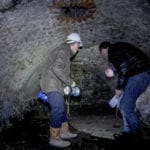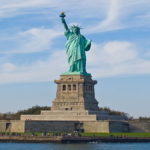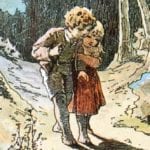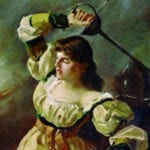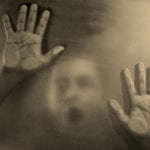 Mysteries
Mysteries  Mysteries
Mysteries  History
History 10 Surprising Stories About the Texas Rangers
 Humans
Humans 10 Philosophers Who Were Driven Mad by Their Own Theories
 Miscellaneous
Miscellaneous 10 Video-Game-Worthy Weapons and Armors from History
 Weird Stuff
Weird Stuff 10 Psychics Who Accurately Predicted Wartime Events
 The Arts
The Arts 10 Pieces of Art Inspired by a Broken Heart
 Health
Health 10 Science Fiction-Sounding New Medical Treatments
 History
History 10 Surprising Facts About the Father of Submarine Warfare
 Space
Space Ten Astonishing New Insights into Alien Worlds
 Weird Stuff
Weird Stuff 10 Bizarre Summer Solstice Rituals Still Practiced Today
 Mysteries
Mysteries Top 10 Haunting Facts About the Ghost Ship MV Alta
 History
History 10 Surprising Stories About the Texas Rangers
 Humans
Humans 10 Philosophers Who Were Driven Mad by Their Own Theories
Who's Behind Listverse?

Jamie Frater
Head Editor
Jamie founded Listverse due to an insatiable desire to share fascinating, obscure, and bizarre facts. He has been a guest speaker on numerous national radio and television stations and is a five time published author.
More About Us Miscellaneous
Miscellaneous 10 Video-Game-Worthy Weapons and Armors from History
 Weird Stuff
Weird Stuff 10 Psychics Who Accurately Predicted Wartime Events
 The Arts
The Arts 10 Pieces of Art Inspired by a Broken Heart
 Health
Health 10 Science Fiction-Sounding New Medical Treatments
 History
History 10 Surprising Facts About the Father of Submarine Warfare
 Space
Space Ten Astonishing New Insights into Alien Worlds
 Weird Stuff
Weird Stuff 10 Bizarre Summer Solstice Rituals Still Practiced Today
Ten Tales from the Troubles of Northern Ireland
From the late 1960s until the late 1990s, Northern Ireland was a killing field, one whose tentacles often extended to the Republic of Ireland in the south and England to the east.
The root cause was simple: Catholics living in British-controlled, predominantly Protestant North Ireland wanted more of a say over their own destiny. They’d been deemed second-class citizens for years, and as the 1960s unfolded, civil rights movements in the U.S. and elsewhere fueled an Irish uprising.
What resulted was what happens when negotiations fail and extremism reigns. Here are ten tales from The Troubles.
Related: 10 Crazy Attempts To Turn Humans Into Suicide Weapons
10 Troubles Brewing: The Roots of the Conflict
It’s impossible to understand The Troubles without comprehending modern Irish history.
In 1916, with British forces bogged down in World War I, Irish nationalists sensed an opportunity. And while their short-lived rebellion was crushed, both the uprising and its harsh British crackdown made independence more popular.
This culminated in the partitioning of Ireland in 1920, with 26 predominantly Catholic counties divorcing themselves from Great Britain. Six northern counties whose population were majority Protestant—largely due to English and Scottish colonization during the early 17th-century Plantation of Ulster—remained loyal to the crown, giving birth to the UK-aligned state of Northern Ireland. Notably, the original Republic of Ireland government was dominated by Sinn Féin, which half a century later would become most recognized as the political engine behind the Irish Republican Army (IRA).
From its inception, Northern Ireland has contained a sizable Catholic minority that favors a united, fully independent Irish island. And while Christian denomination—namely, “Catholics vs. Protestants”—was the most media-friendly way to encapsulate the violence that began in earnest in the late 1960s, the underlying causes were accusations of England-aligned suppression of those who’d rather be citizens of a free Ireland than subjects of the British crown.
In 1998, the Good Friday Agreement ended The Troubles pretty much where they began: Northern Ireland remains part of Great Britain, utilizing the Pound rather than the Euro and, most recently, complicating the UK’s exit from the European Union.[1]
9 The First to Die
While 1969 is considered the year The Troubles began in full force, the first known victim was murdered three years earlier.
On May 27, 1966, a 28-year-old Catholic man named John Scullion was shot near the front door of his Belfast home. The attackers were members of the Ulster Volunteer Force (UVF), a paramilitary group loyal to Great Britain. Scullion died two weeks later.
In the ensuing weeks, the Royal Ulster Constabulary (RUC)—Northern Ireland’s official, Britain-aligned police force—claimed Scullion was stabbed rather than shot, leading to widespread accusations of a crown coverup. Scullion’s remains were exhumed to confirm his cause of death. Later, it emerged that a neighbor of Scullion’s handed the bullet shell to an RUC officer…who then kept it from being entered as evidence.
The triggerman was reported as UVF gang leader Gusty Spence, who gunned Scullion down as he returned from a local pub. (So much for minding your Ps & Qs.) Soon, two more people were murdered by the UVF: a Catholic man named Peter Ward and a Protestant, Matilda Gould, who was killed by mistake. Spence would serve 18 years in prison for Ward’s death.
Scullion’s headstone reads: “Murdered for his faith.” While no one could have fathomed it at the time, his death was just the first of over 3,500 killings spanning more than three decades of sectarian violence.[2]
8 Among the First Victims Was a Nine-Year-Old Boy
In August 1969. British troops were deployed to restore calm in Belfast as Catholics protested and ultimately rioted for fairer treatment and expanded economic opportunities. It was among The Troubles’ first major conflicts.
Streets regarded as Catholic were burned by loyalist mobs, and members of the long-dormant Irish Republican Army (IRA) fought back. As violence escalated, Divis Flats resident (and father of six) Neely Rooney left his loft to investigate. “‘I think it’s getting bad outside,’” his wife, Alice, recalls him saying. A nearby pub was on fire, he noted.
In front of Divis Flats, British troops then tried to disperse protesters by firing over their heads with mounted machine guns. Several penetrated dwellings in the Divis Flats. “The bullets ripped through the place,” said Con Neely, one of Alice and Neely’s now-adult sons. “They came through the windows and ripped through the plasterboard, everything.”
“I saw all the flashes of the tracer bullets going past the flats, and as I opened the door, I must have been grazed with one of them,” Alice remembers. Her husband was hit as well. “Alice, I’m shot,” he muttered. Luckily he would survive.
But then, Alice recalls, her nine-year-old son Patrick “slumped down the wall. I said, ‘God, he’s fainted’…but when I lifted him up, the blood was coming from the back of his head.” The boy died shortly after that, and the shooting was never prosecuted.[3]
7 Safety in Numbers: Belfast’s Self-Segregation
As violence escalated, Catholics and Protestants no longer felt comfortable living shoulder to shoulder. As a result, Catholics in predominantly Protestant neighborhoods moved to Catholic areas and vice versa—a self-segregation that found relative safety in numbers. In short order, entire neighborhoods were discernible primarily by their Christian denomination.
Unfortunately, an unintended consequence was that someone’s sectarian affiliation—previously hidden by the opposing sides’ shared ethnicity—could be easily discerned simply by learning an address. Overnight, the reply to “where you from?” became fighting words.
In late 1969, the British government began erecting a series of walls between Catholic and Protestant neighborhoods—complete with gates that closed each evening. They stayed shut until the next morning; the goal was coexistence via separation. The most prominent of these barricades, now called the Peace Wall, stretches several miles and has been signed by more than four million visitors since The Troubles came to an uneasy end in 1998’s Good Friday Agreement.
Still, just because the violence has subsided doesn’t mean former enemies are becoming fast friends. Many residents still have fresh memories of sectarian bombings and killings. In an area where identity is largely defined by whether one favors Irish nationalism or British loyalty, the willingness to put down arms has outpaced the desire to shake hands.
For example, in 2013, Northern Ireland’s government announced its intentions to remove all sectarian partitions by 2023. As that deadline approaches, over 100 still remain, often dotted with memorials to victims.[4]
6 Sunday, Bloody Sunday
The incident that inspired U2’s hit song occurred on January 30, 1972, in the western city of Londonderry—which, for obvious reasons, is simply called “Derry” by Irish nationalists. It became a pivotal event in The Troubles, with many marking it as a point of no return.
On that day, the Northern Ireland Civil Rights Association had organized a protest march. Despite the protesters being neither armed nor riled up, British soldiers fired upon them with live ammunition. Fourteen people were killed, with 15 others wounded.
The fallout was swift and severe. The next day, a nationalist Northern Ireland MP slapped a loyalist colleague in the face for lying about the extent of the tragedy. The day after that, Dublin’s British embassy was bombed.
But the most consequential result was a spike in violently nationalist sentiment. In the days and weeks following what soon became known as Bloody Sunday, countless vengeful young men joined the IRA, swelling its ranks. The British government’s subsequent exoneration of the soldiers involved only worsened the animus.
The proof is in the body count. In the three years leading up to Bloody Sunday, The Troubles claimed about 200 lives. In 1972, 479 people were killed—the deadliest single year in the three-decade conflict. The annual death toll wouldn’t fall below 200 again until 1977, entrenching the bitterness and emboldening extremists on both sides.[5]
5 The Deadliest Day, and Other Lowlights
On May 17, 1974, a series of four coordinated bombs detonated in the Republic. Three hundred people were injured, and 33 civilians—plus a full-term unborn child—were killed. It was The Troubles’ deadliest day.
Organized by the Ulster Volunteer Force, the same group involved in the Scullion murder above, three explosions went off during the evening rush hour in Dublin. A fourth occurred about 90 minutes later in the border town of Monaghan.
Two years earlier, the nationalists executed their most orchestrated attack. On July 21, 1972, the Provisional IRA (or PIRA, the militant outgrowth of the original IRA) set off 22 bombs in Belfast over a 75-minute span. Dubbed Bloody Friday, the event killed nine, including two British soldiers. In March 1973, the group attacked England for the first time, setting off four car bombs in London that injured more than 200 people. Miraculously, no one died save for a 60-year-old who suffered a heart attack.
In fact, while many point to the April 10, 1998 Good Friday Agreement as the cessation of widespread violence, the carnage would continue for some time. In August of that year, a dissident republican group calling itself the Real IRA exploded a bomb in Banbridge, Northern Ireland, injuring 33 civilians and two Royal Ulster Constabulary officers. Two weeks later, the same group detonated an explosive in Omagh, Northern Ireland, that killed 29 civilians—including a woman pregnant with twins.[6]
4 Doctors of Doom: Assassinated in a Hospital
Máire Drumm was Vice President of Sinn Féin—the IRA-affiliated nationalist political party—and a commander in the Irishwoman’s Council. Among other exploits, she broke through lines of British troops during the July 1970 Falls Curfew, a British police operation that began as a search for illegal weapons but devolved into skirmishes with residents of the Catholic nationalist neighborhood. Drumm and several others risked arrest and harm by taking food and supplies past troops into the encircled area, prompting a de-escalation.
Soon, though, Drumm’s peaceful protest days were over. In 1971, a year before assuming Sinn Féin’s vice presidency, she was arrested for “seditious speech” for encouraging a Belfast audience to join the IRA. She was jailed again in 1976 after threatening to destroy Belfast “stone by stone.”
That fall, Drumm entered a Belfast hospital for eye surgery. Rumor had it that the 57-year-old woman was in ill health and would be resigning her Sinn Féin post and moving to Dublin. On October 28, two members of a secretive loyalist paramilitary group called the Red Hand Commando disguised themselves as doctors, snuck into the hospital, and shot Drumm dead in her bed. Many nationalists saw the lack of adequate security as a British conspiracy to rid themselves of a longstanding thorn.[7]
3 Power Hungry: The Prison Strike That Spurred IRA Recruitment
Whether regarded as a hero or terrorist, Robert “Bobby” Sands was responsible for surging recruitment into the IRA. This is because of how he lived and, especially, how he died.
In 1976, Sands was sentenced to 14 years for bombing a furniture company in retaliation for a British bar bombing. In prison, he was implicated in a fight and sent to the punishment block. There, his cell contained a mattress, chamber pot, water container…and nothing else. Protesting the conditions, Sands refused to wear a prison uniform. Guards responded by keeping him naked for 22 days.
Sands’ obstinance brought notoriety. He had several letters and articles published in the Irish Republican An Phoblacht newspaper and, in 1980, was elected Officer Commanding of the Provisional IRA Prisoners of Maze Prison. Quite the title for a guy in the slammer.
Then Sands started something that showed his utter dedication to Irish nationalism. Under the guise of protesting for better prison conditions, on March 1, 1981, he refused to eat. His cohorts joined the hunger strike at staggered intervals to maximize publicity. A month later, a still-starving Sands was even elected to Parliament.
Sands went 66 days without food, dying of malnourishment on May 5. Nine others starved themselves to death in a prolonged episode credited with changing the course of The Troubles. Sands’s death prompted days of rioting in Northern Island’s nationalist areas, and more than 100,000 people lined his funeral route.[8]
2 The Hateful ’80s
While violence certainly flowed from both sides, Irish nationalists were the clear aggressors throughout the 1980s. Republican groups initiated the overwhelming majority of killings during the decade, many having the look and feel of vulgar, indiscriminate terrorism.
It’s one thing to blow up military ceremonies in London’s Hyde and Regent’s Park, killing 11 British soldiers (and seven horses), as the PIRA did in July 1982. It’s quite another to stick a bomb in an apartment building’s drain pipe—which the Irish National Liberation Army (INLA) did in August 1982. Despite killing a British soldier, it also killed two children (and Catholic children, no less).
The following year, INLA killed three civilians at a Protestant church service, while the PIRA exploded a bomb outside of London’s famous Harrod’s department store, killing six and injuring 90. In 1984, PIRA bombed a hotel where England’s Conservative Party—including Prime Minister Margaret Thatcher—was congregating. Five died, including an MP.
The nationalist killing spree goes on. On November 8, 1987, 11 civilians and an RUC officer were killed when a bomb exploded during a Remembrance Day ceremony in the ironically named town of Enniskillen, Northern Ireland. The next year, PIRA tried to blow up a High Court Judge in the equally ironically named border town of Killeen, North Ireland. They missed, instead killing a family of three, including a six-year-old boy.[9]
This is not the way to rally the world to your cause, people.
1 A Troubling Truth: Northern Ireland Today
For Northern Ireland to evolve beyond its ugly past, many older residents may need to take their intractable grievances to the grave. The Troubles may need to age out, leaving Northern Ireland to a generation that grew up in peace, however uneasy.
Even today, many young adults in Northern Ireland remember scarring sectarian violence. “The worst thing I ever saw,” said 20-year-old Luc Baxter, “was an exploding head of someone who’d been hit by a bullet. I was 11 years old then.” This means the incident occurred over a decade after 1998’s Good Friday Agreement.
And while this emerging generation doesn’t share its parents’ animosities, it is still very much affected by them. To this day, fewer than 10% of students in Northern Ireland attend religiously integrated schools. Promisingly, parents and teachers have started the “Are You ‘In’?” campaign to expedite Catholic/Protestant school integration.
Older citizens are typically less forgiving. “There were so many people killed just walking around this area,” recalls Frank Brennan, 70, of Short Strand, a working-class Catholic neighborhood in Belfast that runs along the Peace Wall. Brennan, who served prison time for his involvement with the Irish nationalist movement, will likely never be ready to intermingle. “I live on a peace line, and I feel safer with those walls up,” he claims, echoing the stance of many in his generation.[10]

